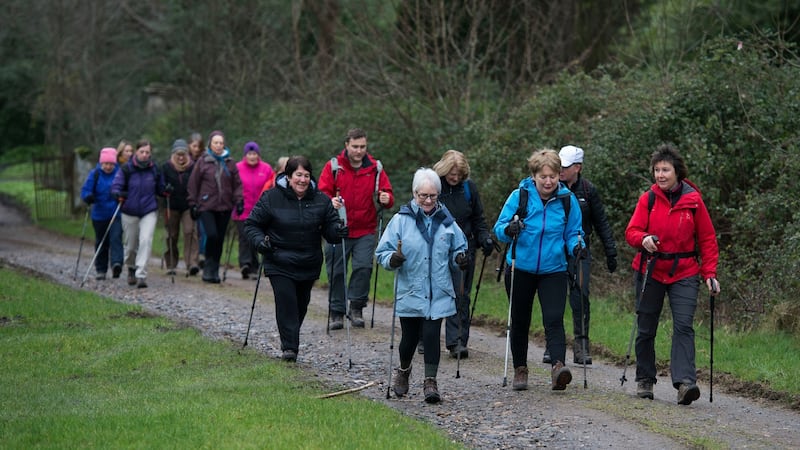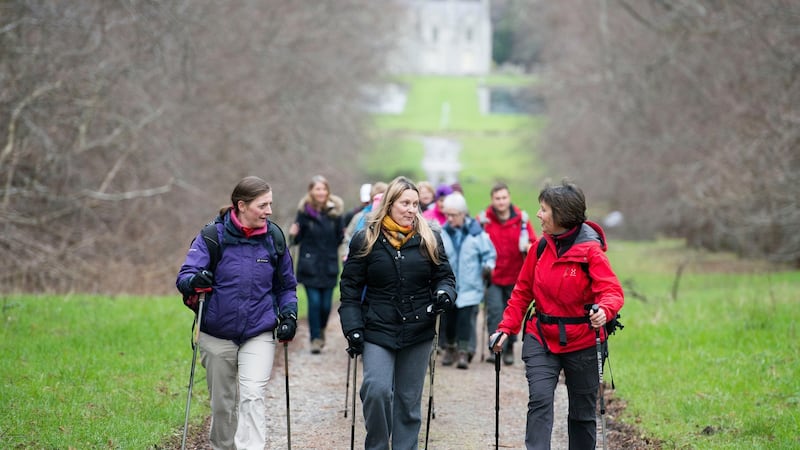Nordic walking originated as summer training for cross-country skiers in Finland. These days, groups of adults can be seen in parks and woodlands across Ireland walking with their poles – winter and summer – like it's something they've done all their lives.
The main devotees of this rhythmical walking are older women and men, who are retired or semi-retired and keen to keep in good shape while enjoying the outdoors and the company of others.
Dr Kathleen Barry is a founding member of Ireland's first Nordic walking club. The Dublin Phoenix Nordic Walking Club (nordicwalkers.ie) was set up in October 2008 and has 60 members, each of whom pay €20 per year and €40 for an induction course with chartered physiotherapist Joy Edge. "Our group are mainly aged in their 50s and 60s so I was keen that anyone joining the group be screened for physical ailments first by Joy Edge – who is a Nordic walking instructor tutor and chartered physiotherapist. She also gives them training in how to warm up, cool down and how to use the poles," explains Dr Barry, a retired public health doctor.


Security and balance
The key difference between regular walking and Nordic walking is the extra upper body workout. Held at an angle to the rear as you walk, the poles exercise muscles in the arms, shoulders, chest, abdomen, back and neck. “Our club attracts people who have had an interest in activity all their lives and like the great outdoors. The poles make walking easier by giving you security and balance so you’re not as tired afterwards. They also distribute the effort on to all four limbs while giving you a full body workshop. You forget you’re doing exercise as you walk and talk. It’s very sociable,” explains Barry.
Nordic walking instructor and Fáilte Ireland tour guide Dairine Nuttall brings out groups of Nordic walkers in north Wicklow and south Dublin three to four times a week. She says one of the great benefits of Nordic walking is people can chat as they walk which has mental health benefits. "There are a lot of lonely and sedentary people out there, so the social aspect of Nordic walking is important. It's an outdoors, muddy, unglamorous sort of activity that suits all ages, weights and levels of fitness," says Nuttall.
“The main thing is that people enjoy walking outdoors. I tend not to correct people too much when they are walking but we always do warm-up exercises and a bit of instruction on using the poles.”
Although some people buy their own poles, Nuttall keeps a supply for new walkers to try out and will bring groups out by arrangement (meetup.com/Wicklow-nordic-walking/).
Nordic walking is a recommended physical activity for those recovering from breast cancer, lung or cardiovascular problems, joint replacements and some chronic pain conditions. “It’s particularly good for anyone who’s had breast cancer and it’s also good for shoulder and neck problems,” says Barry. It is also suitable for those keen to lose weight who don’t usually feel comfortable walking up hill.
Moya Belton has become a regular over the last three years. "I had osteoarthritis in my foot about 10 years ago and I was going on holidays to Machu Picchu and I needed to be able to walk well. I joined a Nordic walking group, led by Dairine Nuttall and built up from the slow to the moderate to the fast class," explains Belton.
A heart problem two years ago set her back, but since then she has built back up her fitness. “I played basketball and hockey when I was younger. I can’t jog or run now so walking suits me,” she says.
Paulene Gogan is a retired nurse who took it up as a social and physical activity. "I retired in 2007 and was delighted not to be a slave to the alarm clock at the start, but I live alone and it's not easy to motivate yourself to walk. I checked out the Shankill Ramblers [a hill-walking group] but their walks are long and the groups are big. Then, I met Dairine and I really enjoy walking with her group. She makes it very personal and is astute to each of our capabilities."
Upper-body exercise
Jim Forde
is a member of the Dublin Phoenix Nordic Walking Club. He had quadruple bypass heart surgery 13 years ago when he was in his 60s. Now nearly 78, he partakes in a cardiac keep-fit class twice a week as well as going out Nordic walking. “I was a hill walker but I only discovered walking with the poles seven or eight years ago. It’s the upper-body exercise which is great for the heart. I go out every Saturday and sometimes on a Monday as well.”
Edge, who set up nordicwalking.ie, says the key to Nordic walking is that as the pole pushes down and back, your body is pushed upwards and forwards. “That gives you a nice gliding, flowing walk with good posture. It’s based on your natural gait and natural walking rhythm but the poles help you walk more efficiently and symmetrically.”
Edge trained as a Nordic walking instructor in 2004 and now runs the International Nordic Walking Association’s instructor training programme in Ireland.
Stepping out: Nordic walking
Nordic walking is walking with specially designed adjustable height poles which you attach to your wrists with Velcro strips. You place the poles into the ground behind you as you walk in a rhythmical fashion – the left pole hits the ground as your right foot advances and vice versa.
The key is to get into a rhythm without thinking too much about it. The poles give the upper body a gentle workout as you walk. The poles are also very useful as supports if you are walking uphill on rough terrain.
As part of my research for this article, I went on a two-hour walk with Nordic walking instructor Dairine Nuttall.
Initially, I was concerned I'd find the poles a nuisance and I'd struggle with my co-ordination. But, surprisingly, I got into the rhythm quite quickly. The realisation that the poles are kept at an angle behind the body helped me manage them better.
If you’ve ever skied, you’ll be familiar with the sensation of having poles to guide you and this helps. Then, it’s all about enjoying your surroundings and the fresh air while you walk at a pace that suits you best.
Sylvia Thompson












